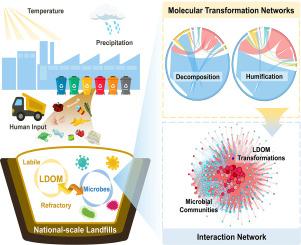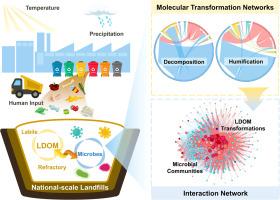微生物介导的转化塑造了人为和自然共变条件下垃圾渗滤液的分子多样性
IF 12.4
1区 环境科学与生态学
Q1 ENGINEERING, ENVIRONMENTAL
引用次数: 0
摘要
人类活动产生的大量垃圾填埋场渗滤液是最难处理的液体废物之一,因为渗滤液中存在顽固的溶解有机物(LDOM)和各种污染物。然而,关于LDOM复杂性的关键驱动力仍然不清楚。以中国国家级垃圾渗滤液为研究对象,探讨了LDOM化学成分、微生物群落、人为因素与气候条件的关系。结果表明,虽然垃圾填埋场废弃物来源于人类排放,但微生物主导了LDOM的分子组成多样性,其次是气候。为了进一步阐明LDOM多样性与微生物群落之间的相互联系,我们建立了一个两阶段的网络框架:首先构建分子转化网络以阐明LDOM的腐殖化和矿化作用,然后构建相互作用网络将可定义的反应与微生物群落联系起来。网络分析显示,微生物促进了LDOM中顽固性成分的积累,削弱了人为引起的差异。氨基酸代谢在微生物介导的LDOM转化中尤为突出,并确定了潜在的关键微生物物种。本研究加深了对垃圾填埋场有机质演化的认识,也为探索人工和天然水体中微生物介导的DOM分子转化提供了新的范式。本文章由计算机程序翻译,如有差异,请以英文原文为准。


Microbial-mediated transformation shapes the molecular diversity of landfill leachate under anthropogenic and natural covariation
Extensive landfill leachate from human activities is one of the most intractable liquid waste due to the presence of stubborn leachate dissolved organic matter (LDOM) and various pollutants. However, critical driving forces regarding LDOM complexity are still unclear. This study explores relationships between LDOM chemical composition, microbial community, anthropogenic factors and climate conditions based on national-scale landfill leachates in China. The results indicate that although landfill wastes originate from human emissions, microbes dominate molecular composition diversity of LDOM, followed by climate. To further elucidate the interlink between LDOM diversity and microbial communities, a two-stage network framework is established: first constructing molecular transformation networks to clarify humification and mineralization of LDOM, succeeded by building an interaction network that links definable reactions to microbial communities. Network analyses reveal that microorganisms promote accumulation of recalcitrant components in LDOM, weakening human-induced differences. Amino acid metabolism was particularly prominent in microbial-mediated transformation of LDOM, and the potential keystone microbial species are identified. This study deepens the understanding of the evolution of organic matters in landfills, also provides a new paradigm for exploring microbial mediated molecular transformation of DOM in both artificial and natural waters.
求助全文
通过发布文献求助,成功后即可免费获取论文全文。
去求助
来源期刊

Water Research
环境科学-工程:环境
CiteScore
20.80
自引率
9.40%
发文量
1307
审稿时长
38 days
期刊介绍:
Water Research, along with its open access companion journal Water Research X, serves as a platform for publishing original research papers covering various aspects of the science and technology related to the anthropogenic water cycle, water quality, and its management worldwide. The audience targeted by the journal comprises biologists, chemical engineers, chemists, civil engineers, environmental engineers, limnologists, and microbiologists. The scope of the journal include:
•Treatment processes for water and wastewaters (municipal, agricultural, industrial, and on-site treatment), including resource recovery and residuals management;
•Urban hydrology including sewer systems, stormwater management, and green infrastructure;
•Drinking water treatment and distribution;
•Potable and non-potable water reuse;
•Sanitation, public health, and risk assessment;
•Anaerobic digestion, solid and hazardous waste management, including source characterization and the effects and control of leachates and gaseous emissions;
•Contaminants (chemical, microbial, anthropogenic particles such as nanoparticles or microplastics) and related water quality sensing, monitoring, fate, and assessment;
•Anthropogenic impacts on inland, tidal, coastal and urban waters, focusing on surface and ground waters, and point and non-point sources of pollution;
•Environmental restoration, linked to surface water, groundwater and groundwater remediation;
•Analysis of the interfaces between sediments and water, and between water and atmosphere, focusing specifically on anthropogenic impacts;
•Mathematical modelling, systems analysis, machine learning, and beneficial use of big data related to the anthropogenic water cycle;
•Socio-economic, policy, and regulations studies.
 求助内容:
求助内容: 应助结果提醒方式:
应助结果提醒方式:


